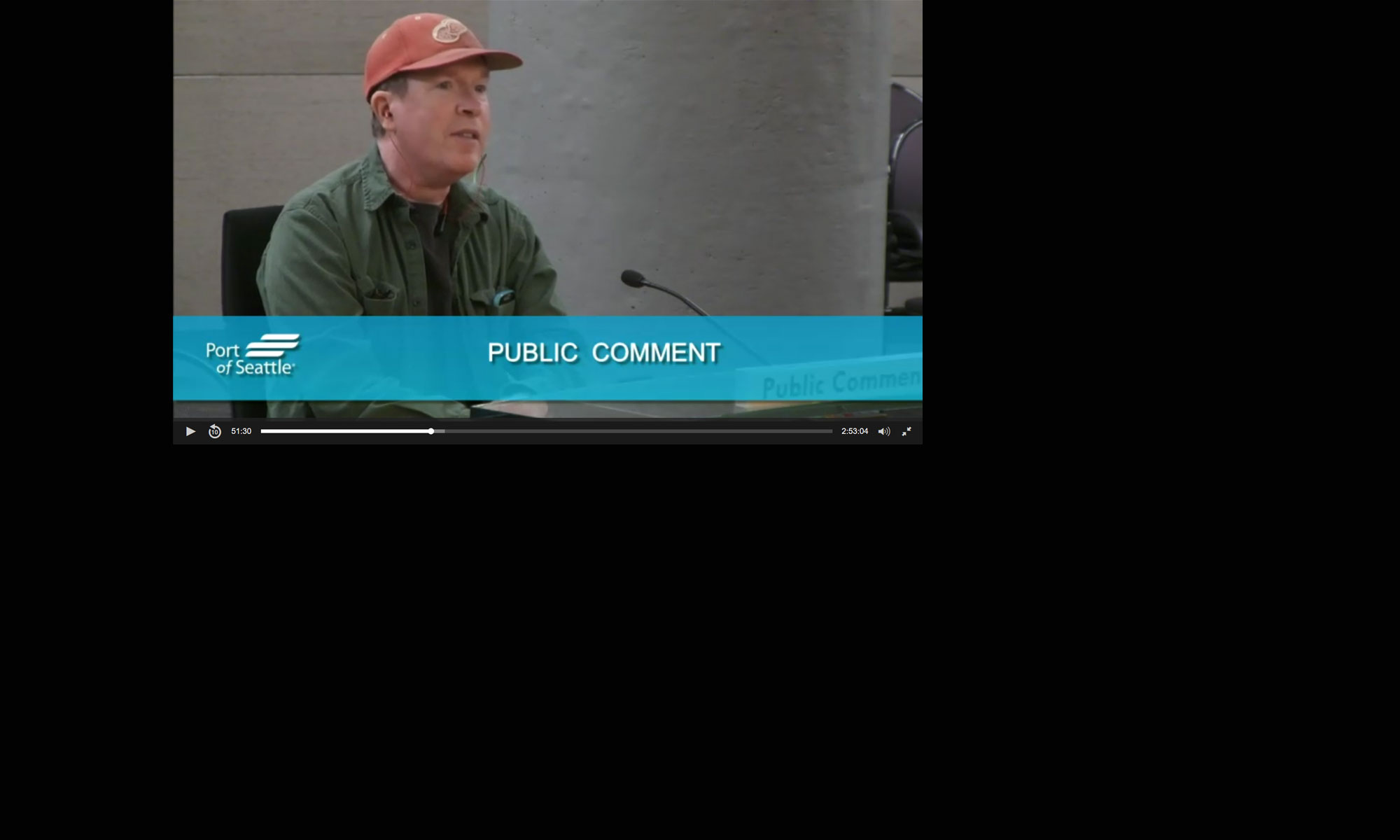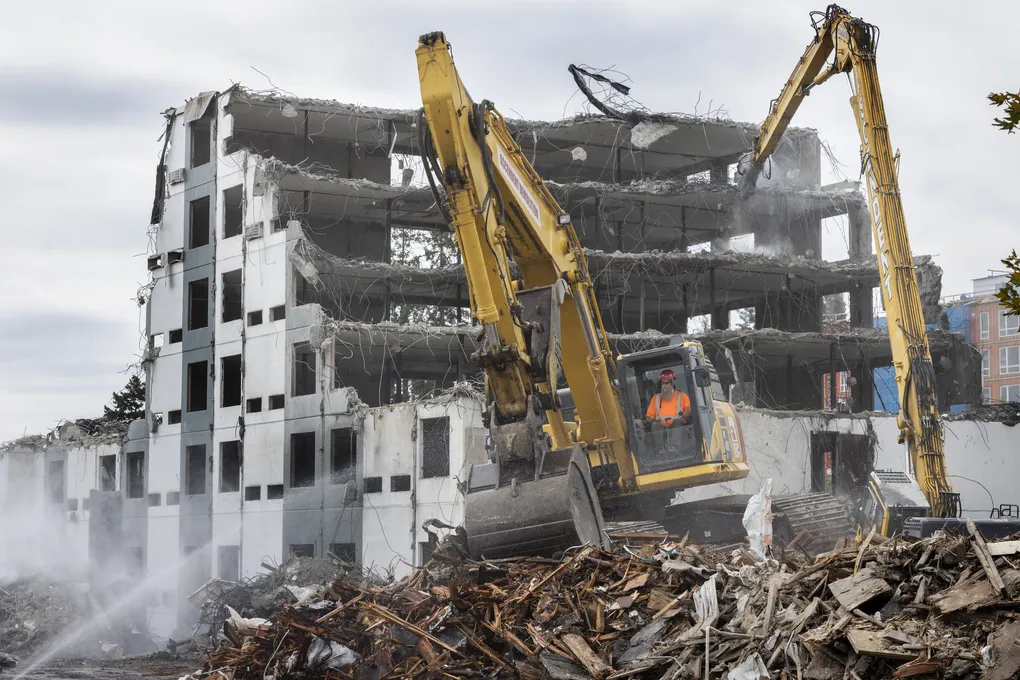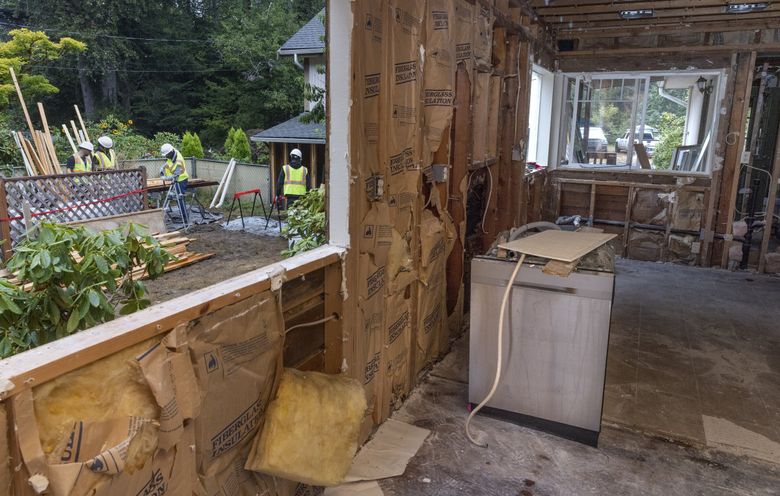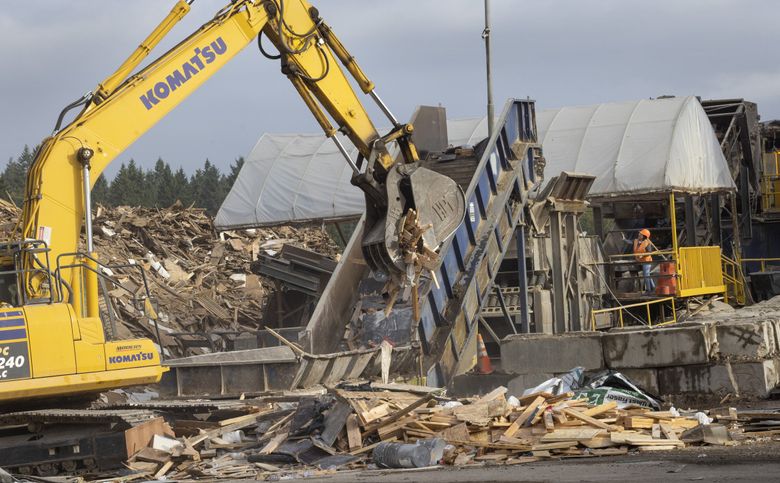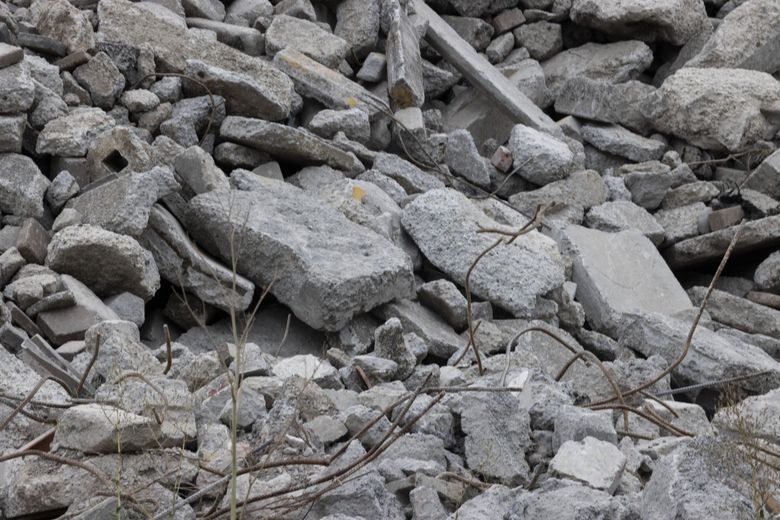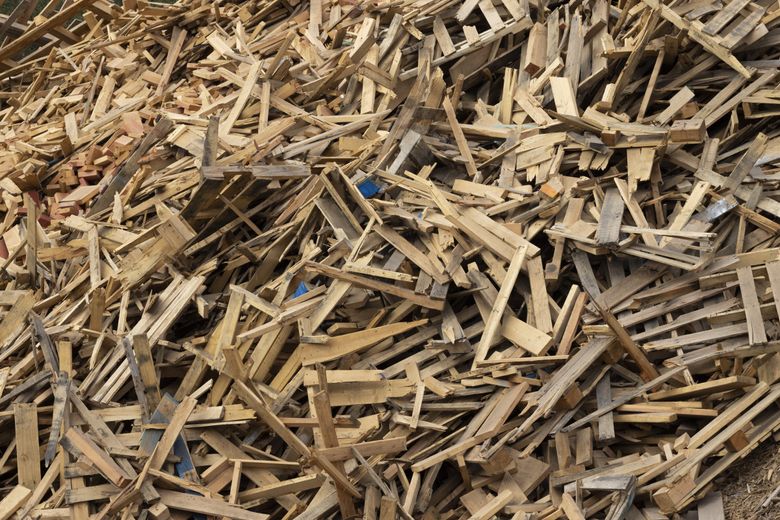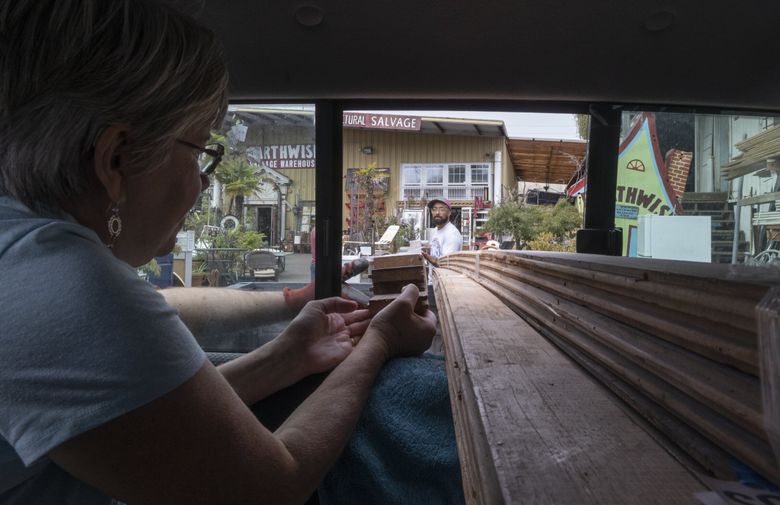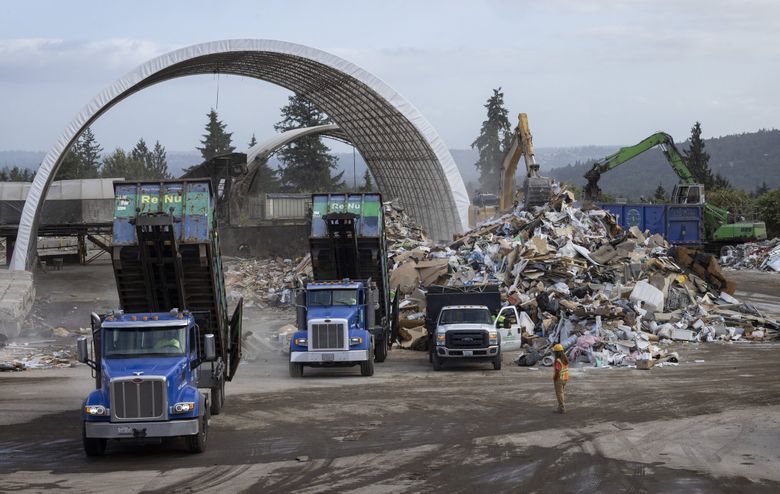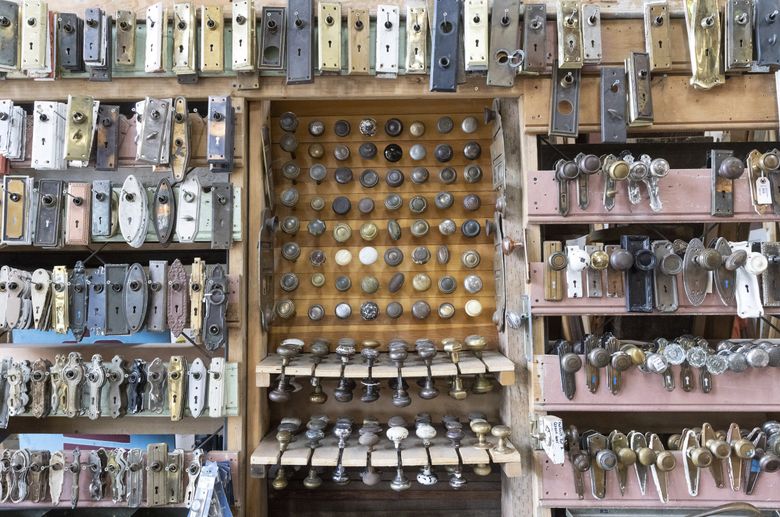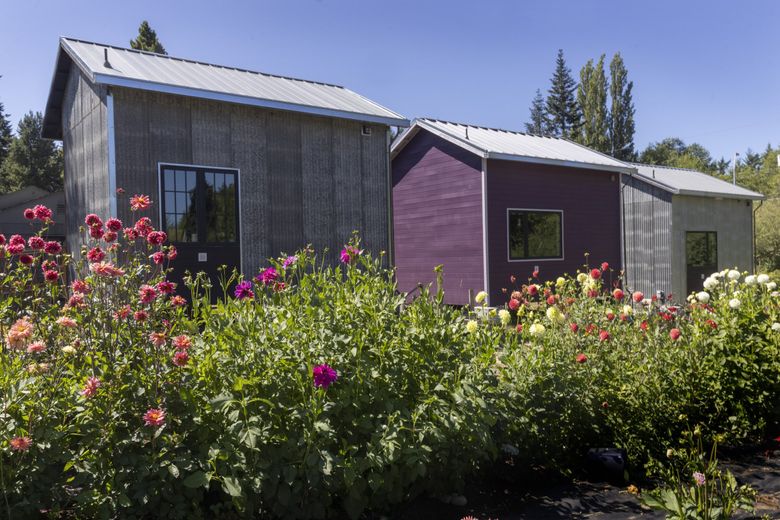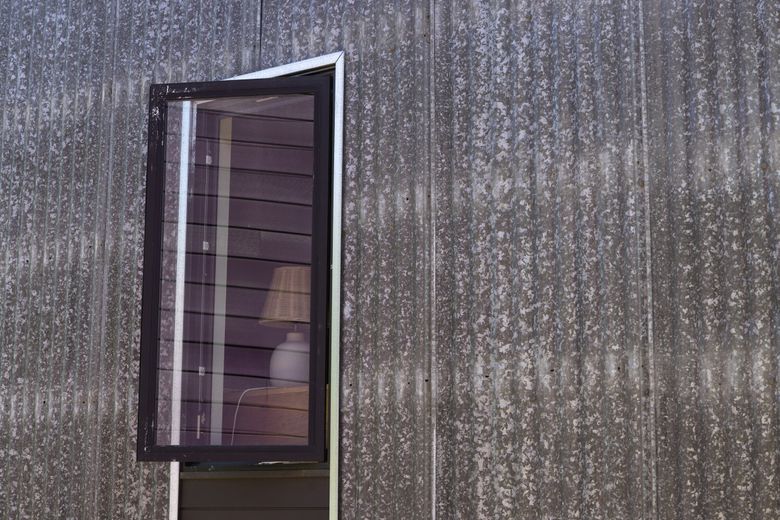THE TWO-STORY HOUSE on the banks of the Cedar River looks as if it’s been sucked up by a twister and plopped back down. Most of the roof lies in chunks on the ground. Several walls are stripped to the studs. Only a couple of doors remain on their hinges, and the kitchen cupboards are on the other side of the yard.
But what might be mistaken for a natural disaster is actually an orderly process. As part of a King County training program, this structure in Maple Valley is being deconstructed — taken apart piece by piece.
“The rule of thumb with deconstruction is last on, first off,” explains Kinley Deller, who manages the county’s construction and demolition waste program. Crews start with the interior, pulling away trim, cabinets and fixtures. Next come the drywall and ceilings. The roof was cut into sections and popped off from the inside.
Materials are separated by type, Deller says, pointing to piles draped with tarps against the drizzle. One mound is clean wood; another is drywall. Downspouts, gutters and other metals make up a third heap. Windows are stacked on the back porch. In an apartment over the garage, two trainees — who enrolled in the program to learn a new skill — are prying up oak flooring. In the side yard, others are using drills and a pneumatic punch to remove screws and nails from 2x4s.
The scene is in sharp contrast to conventional demolition, which relies on heavy machinery to reduce buildings to rubble as quickly as possible. Deconstruction is all about reclaiming building materials so they can be used again.
“There’s a lot of valuable stuff here,” says Deller, who’s on a mission to reduce the staggering amount of waste produced by the construction industry and find new markets for old lumber and other materials that are now mostly treated like garbage.
THE U.S. ENVIRONMENTAL Protection Agency estimates 600 million tons of construction and demolition (C&D) debris were generated in the United States in 2018 — more than double the amount of municipal solid waste. In Washington, nearly 1 million tons of boards, roofing, insulation, bent nails, floor tiles, cabinets, countertops and everything else that makes up a house were buried during a one-year period between 2020 and 2021 — surpassing any other category of trash by weight, according to an Ecology Department analysis. The tonnage is roughly equivalent to the mass of materials in more than 14,000 single-family homes.
“It’s unsustainable,” says Quest Jolliffe, who’s part of Deller’s team. “It doesn’t make any sense for us to go out to the forests and mines and harvest all this material; turn it into something; then, after a 50-year life cycle, smash it all, put it in a hole and start over again.”
Yet for such an enormous waste stream, C&D debris is largely invisible to the public.
A backhoe might roll into your neighborhood and pulverize an old house in a couple of days, a process some in the industry call “crunch and munch.” The mishmash is shoveled into a shipping container and whisked away. Before you know it, a grander home is being framed up on the scraped earth.
Even regulators have a hard time keeping tabs on all the waste, which is shipped from job sites via complex networks of haulers and rail lines and processed at industrial facilities across multiple jurisdictions. King County’s single C&D enforcement staffer has uncovered permit violations and illegal dumping by shadowing trucks, but there’s only so much ground he can cover.
THE NEW DECONSTRUCTION TRAINING is among several initiatives in King County and Seattle to try to reign in the rampant waste. They include incentives for builders and grants to expand retail salvage outlets and processing of old lumber. But deconstruction takes longer and costs more than demolition. In an industry where time is money, observers say it probably will require regulation to change practices.
“We can easily save 3 to 4 tons of usable lumber out of a typical house,” says Ben Pearson, co-owner of Sledge Seattle, which specializes in taking buildings apart. “But you can’t expect most builders or homeowners to pay (a premium) just to do the right thing. That’s not how the world works.”
When Portland was beset by a frenzy of demolition after the Great Recession, residents mobilized in protest, and the city adopted the nation’s first ordinance requiring deconstruction of older homes. Cities as disparate as San Antonio, Pittsburgh and Palo Alto have enacted similar policies. Several Washington communities, including Seattle, King County and Kenmore, are considering the idea — not only to reduce waste, but also to address the energy and carbon costs of harvesting and manufacturing new materials.
“The greenest building is the existing building,” says Katie Kennedy, Seattle’s C&D waste lead. “We need to better consider when we tear down a building: Can it be reused, or can it be dismantled for its parts instead of throwing the whole thing away?”
IF YOU FOLLOW a dumpster from a demolition site in King County, there’s a good chance it will wind up at a facility such as the one operated by DTG Recycle in Snohomish.
Despite Washington’s green reputation, Seattle and King County are among the only municipalities that mandate recycling of some types of C&D waste, including clean wood, drywall, concrete and metal. DTG’s business is to recover as much usable material as possible from the debris.
The Snohomish plant can process more than 400 tons per day of mixed construction waste, chief revenue officer Erin Gagnon says during a visit in late summer. One part of the sprawling site is dominated by a mountain of broken concrete, which the company crunches up into gravel and aggregate. An adjacent foothill glitters with marble countertops. DTG fractures the slabs into decorative rock.
The main action is at the central yard, where trucks loaded with construction waste back up and dump onto the ground. An excavator makes a rough sort, plucking out tangles of worthless plastic and laminate and pushing wood, metal and drywall toward a conveyor belt, where workers pick out anything DTG can sell.
Their mainstay is wood, Gagnon says. Ground up into a mix of chips and shavings, it’s burned as fuel by pulp mills and other industries. DTG also recently started turning scrap wood into landscaping mulch.
But plucking valuables from a stew of crushed material is inherently inefficient. Gypsum is easy to recycle into new drywall, for example, but not if it’s been pounded into powder at demolition sites. During the height of the construction season in July, only 36% of the waste handled at the Snohomish plant actually was recycled. The rest was loaded into rail cars and shipped to landfills.
The company could process more materials, such as asphalt shingles, if there were markets, Gagnon says. Some states mandate a certain percentage of recycled content in road aggregate and asphalt paving, but Washington doesn’t.
“It’s great to want to recycle things,” she says, “but there really has to be an end market, and sometimes that requires a policy mandating use of the recycled material.”
RECYCLING IS PREFERABLE to landfilling, but it’s far better for the environment to reuse materials, says Dave Bennink, who’s leading King County’s deconstruction class.
Bennink has been salvaging building materials for more than three decades, starting at The RE Store in Bellingham. He’s helped start more than 80 other retail stores, trained hundreds of workers through his Building Deconstruction Institute and estimates his own salvage operations have saved 10,000 acres of forest.
“This type of work generates so much good,” he says. “We help the environment. We promote historical preservation; we create jobs and provide affordable building materials to the community.”
There has always been a market for things such as brass hinges, exquisite moldings, solid wood doors and other gems rescued from old buildings. But it’s mostly a niche enterprise catering to boutique builders and DIY-ers, particularly those looking for irreplaceable old-growth wood that far outstrips the quality of new lumber.
To make deconstruction more appealing to builders, contractors such as Sledge Seattle offer a hybrid version, using machinery for some of the work while saving the best parts of a house. Bennink is experimenting with removing stairs, decks, walls and floor sections intact and marketing them as what he calls “assemblies.” His latest product is a package of salvaged materials that includes everything necessary to build a shed.
A time-lapse video shows Sledge Seattle deconstructing a house in Wallingford. (Courtesy of Sledge Seattle)Since Portland’s ordinance was enacted in 2016, more than a dozen new deconstruction firms have sprung up, along with new salvage retail outlets. Because older materials are generally superior, the ordinance initially targeted homes built in 1916 or earlier. The cutoff was later shifted to 1940, which covers the majority of houses taken down in the city.
Officials estimate contractors have salvaged more than 5.5 million pounds of lumber, with carbon emission savings equivalent to taking 900 cars off the road. The biggest challenge now is finding markets for all that salvaged wood, which in some cases is stacking up in warehouses.
“URBAN MINING” is the term sustainability advocates use to describe tapping into the wealth of materials in existing buildings. But the construction industry isn’t wired to do that, says architect Felix Heisel, director of the Circular Construction Lab at Cornell University. Old lumber is often oddly sized. Some materials don’t meet modern building codes, and nothing comes with a warranty. Heisel and his team had to conduct five laboratory tests on salvaged steel beams before they got approval to incorporate them into a structure in Germany.
“There are a lot of little, but important, barriers that need to be overcome for reuse to happen,” he says.
One of his projects is developing a digital “passport” for different types of materials that includes structural specifications. He recently completed a comparison study that found deconstruction can be cost competitive with demolition when the value of salvaged materials is factored in along with the energy and carbon benefits. But someone has to reuse those materials.
Seattle builder Linda Pruitt, whose Cottage Company specializes in sustainable, smaller homes, recently partnered with Sledge Seattle to deconstruct an 8,000-square foot, 1950s-era church in the northeast part of the city. She recouped most of the deconstruction costs by selling salvaged materials or incorporating them into the nine homes she’s building at the site — which also earned her points toward five-star Built Green certification. But it wasn’t always easy.
She had to cajole her framing crews to use the old lumber. “It’s not what they’re used to. They want to see something packaged and delivered from the lumber yard.”
Perhaps the biggest treasure was the clear fir paneling that lined the interior of the sanctuary. Pruitt spent $10,000 to have it milled into flooring that would have cost more than $40,000 new.
“To me, that’s where the real win is in deconstruction — when you can repurpose something to a higher finished use,” she says.
Seattle and King County have been working to boost capacity and increase markets for reused building materials before taking up the question of deconstruction mandates. Seattle now requires salvage assessments — professional surveys to identify valuable materials — before most major remodels and demolition projects. Owners and builders don’t have to actually follow up, but local salvage contractors say they’ve seen an uptick in business, anyway.
King County recently awarded grants to Earthwise Architectural Salvage to open a new branch in Kenmore and purchase milling equipment to process old lumber into more useful forms. Another grant went to a craftsman who makes furniture from reclaimed wood. The next step is leveraging a recent $4 million Environmental Protection Agency grant to the city of Seattle to establish a central warehouse where salvaged lumber can be sorted, processed and sold — which should prevent the type of backlog Portland is grappling with.
At the state level, the advocacy group Zero Waste Washington is working on legislation to divert more organic waste, including wood, from landfills. “There really does seem to be a lot more momentum building across the country to address construction waste,” says Heather Trim, the group’s executive director.
ONE EXAMPLE OF what might be called ultimate reuse already exists on Bainbridge Island. After years in the business, architect Matthew Coates was so disgusted by the level of waste at construction sites, he set out to show it’s possible to build almost entirely with reclaimed materials.
Working with Clark Construction, Coates designed three tiny homes to serve as housing for interns at the agricultural nonprofit Friends of the Farm. The community response was astounding, he says, walking the grounds where the structures sit amid greenhouses and cultivated fields. Donated materials poured in from contractors, businesses and individuals.
“All this siding came from an old barn that was deconstructed,” he says, pointing to the corrugated metal that sheathes several exterior walls. Stairs and a wheelchair ramp were built with wood pulled from the facade of a medical center Coates was remodeling into a police station. Interior cupboards and sinks came from exam rooms in the same building, while the metal roofs were discovered moldering in a field.
The windows don’t match, but they were free — the wrong sizes from custom jobs. Two of the structures gleam with tiger wood siding, which had been sitting under a tarp in Coates’ yard for more than a year. Local builders dropped off surplus insulation and nails and fasteners. Workers nailed reclaimed 2x4s together to fabricate 10-foot-tall studs.
“Every single item in those buildings has a story behind it,” Coates said. “And it all would have gone to the dump.”
It’s not the type of project likely to be replicated at commercial scale. The work stretched over three years, and Coates did the design pro bono. Scores of volunteers pitched in to pull nails and sort materials.
But demonstration projects serve as beacons to prove the feasibility of less-wasteful approaches to construction, Heisel, of Cornell University, points out.
“We’re not yet successful in scaling it to the new status quo,” he says, “but I think we have proven it’s possible.”


